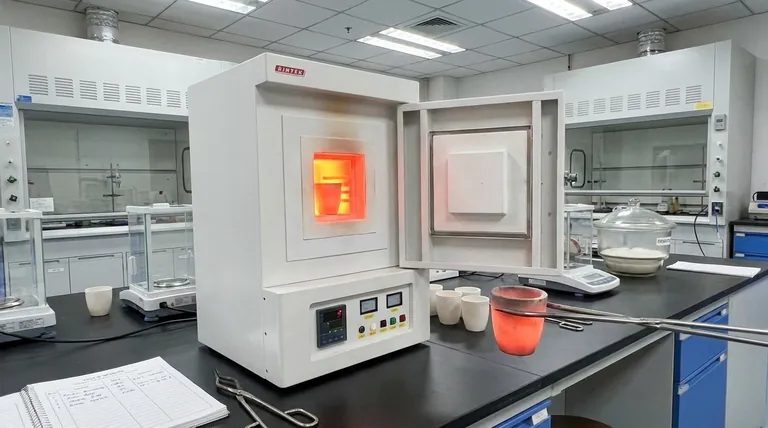The dry ashing method is a widely used analytical technique for determining the composition of a sample in its dry state. It involves heating the sample in a muffle furnace at high temperatures (typically 500-600°C) to oxidize and remove organic material, leaving behind inorganic residues such as oxides, sulfates, phosphates, and silicates. This method is advantageous due to its simplicity, cost-effectiveness, and ability to handle large sample volumes. However, it may be less accurate for samples containing volatile materials. The ash content is calculated based on the weight difference before and after ashing, providing valuable insights into the mineral composition of the sample.

Key Points Explained:
-
Simplicity and Ease of Use:
- Dry ashing is a straightforward process that requires minimal sample preparation. The sample is simply placed in a muffle furnace and heated to high temperatures. This simplicity makes it accessible for routine analysis in laboratories.
- The method does not require complex reagents or equipment, reducing the likelihood of errors associated with handling hazardous chemicals.
-
Cost-Effectiveness:
- Dry ashing is relatively inexpensive compared to other analytical techniques. The primary equipment required is a muffle furnace, which is a one-time investment.
- There are no ongoing costs for expensive chemicals or reagents, making it a cost-effective option for laboratories with budget constraints.
-
Handling Large Sample Volumes:
- Dry ashing is well-suited for analyzing large sample volumes. The muffle furnace can accommodate multiple samples simultaneously, increasing throughput and efficiency.
- This makes it particularly useful in industries such as food, agriculture, and environmental science, where large-scale analysis is often required.
-
Mineral Composition Analysis:
- The method effectively converts minerals in the sample into stable inorganic compounds such as oxides, sulfates, phosphates, and silicates. These compounds can then be analyzed to determine the mineral content of the sample.
- This is particularly useful in industries like food science, where the mineral content of food products is a critical quality parameter.
-
Removal of Organic Material:
- Dry ashing completely oxidizes and removes organic material from the sample, leaving behind only inorganic residues. This is beneficial for analyzing the inorganic composition of samples without interference from organic matter.
- The process is particularly useful in environmental analysis, where the focus is often on the mineral content of soil, sediment, or ash samples.
-
Calculation of Ash Content:
- The ash content is calculated using the formula: [ \text{Ash content} = \frac{M(\text{ash})}{M(\text{dry})} \times 100% ] where (M(\text{ash})) is the weight after ashing and (M(\text{dry})) is the weight before ashing. This provides a quantitative measure of the inorganic content in the sample.
- This calculation is straightforward and provides a reliable measure of the sample's mineral content.
-
Limitations and Considerations:
- While dry ashing has many advantages, it is less accurate for samples containing volatile materials, as these may be lost during the heating process. This can lead to underestimation of the ash content.
- The method is also not suitable for samples that may form volatile compounds at high temperatures, as this can lead to incomplete ashing and inaccurate results.
-
Applications in Various Industries:
- Food Industry: Used to determine the mineral content of food products, which is important for nutritional labeling and quality control.
- Agriculture: Used to analyze soil and plant samples to assess nutrient content and soil health.
- Environmental Science: Used to analyze ash and sediment samples to determine pollution levels and environmental impact.
In conclusion, the dry ashing method offers several advantages, including simplicity, cost-effectiveness, and the ability to handle large sample volumes. It is particularly useful for analyzing the mineral composition of samples and removing organic material. However, it is important to consider its limitations, especially when dealing with volatile materials. Overall, dry ashing is a valuable tool in various industries for determining the inorganic content of samples.
Summary Table:
| Key Aspect | Details |
|---|---|
| Simplicity | Minimal sample preparation, no complex reagents or equipment required. |
| Cost-Effectiveness | One-time investment in a muffle furnace; no recurring chemical costs. |
| Large Sample Handling | Accommodates multiple samples, ideal for industries like food and agriculture. |
| Mineral Composition | Converts minerals into oxides, sulfates, phosphates, and silicates for analysis. |
| Organic Material Removal | Oxidizes organic matter, leaving inorganic residues for accurate analysis. |
| Ash Content Calculation | Formula: [\text{Ash content} = \frac{M(\text{ash})}{M(\text{dry})} \times 100%] |
| Limitations | Less accurate for volatile materials; may underestimate ash content. |
| Applications | Food industry, agriculture, environmental science. |
Discover how the dry ashing method can streamline your lab processes—contact us today for expert guidance!
Visual Guide

Related Products
- 1700℃ Muffle Oven Furnace for Laboratory
- 1400℃ Muffle Oven Furnace for Laboratory
- 1800℃ Muffle Oven Furnace for Laboratory
- Laboratory Muffle Oven Furnace Bottom Lifting Muffle Furnace
- 1400℃ Laboratory High Temperature Tube Furnace with Alumina Tube
People Also Ask
- What hazard is involved when using a furnace? Protect Your Home from the Silent Killer
- What affects the melting point of a substance? Uncover the Key Factors & Forces
- Do different liquids melt at different rates? Unlock the Science of Melting Points and Material Properties
- What is the difference between a crucible and a furnace? Understanding the Heat Source and Container Partnership
- Does melting point ever change? Unlock the Secrets of Pressure and Purity



















